INTRODUCTION
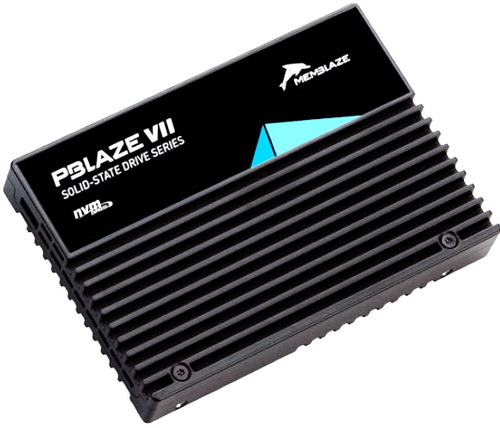
Even though the very first consumer SATA SSDs released just under 2 decades ago introduced performance levels new to everyone durability wasn't their strongest selling point (several models died inside a single year, some inside a few days during my tests). Needless to say, today things have improved massively in that regard but If I once again was to nitpick, I'd point out that high performance doesn't always go hand to hand with durability when it comes to consumer oriented SSDs, quite the opposite actually. This of course doesn't apply for enterprise/industrial type SSDs and with demand for such drives on the rise it's no surprise to see more storage manufacturers design and release such models in the market. Memblaze is one such manufacturer and today with me I've got their most popular model to date, the PBlaze7 7940 3.84TB U.2 PCIe Gen5 NVMe SSD.
Memblaze is a leading provider of enterprise-class SSD products and solutions, founded in Beijing in 2011, the PBlaze series of enterprise SSDs launched by Memblaze has been widely used in database, virtualization, cloud computing, big data, artificial intelligence and other fields, providing stable and reliable high-speed storage solutions for Internet, cloud services, finance and telecommunications industries. Memblaze has been committed to independent development and innovation, owning over 200 flash technology patent applications, covers key areas such as flash memory management, data protection, power control, hardware design, and has R&D centers in Beijing, Shanghai, Suzhou and Chengdu.
The PBlaze7 7940 series of PCIe 5.0 SSDs by Memblaze was released back in August 2023, is available in several different form factors (2.5-inch U.2, E1.S, E3.S, HHHL AIC) and capacities (3.84/7.68/15.36/30.72TB) and is based on the Bravera SC5 (MV-SS1333) PCIe 5.0 NAND flash Controller by Marvell. Memblaze has paired the Bravera SC5 NAND flash controller with Micron's B58R FortisMax 232-layer 3D TLC NAND flash (2400MT/s speed) and a grand total of 4.6GB DDR4 DRAM 3200Mbps (22-22-22 timings) by Nanya (for the 3.84TB model which I have with me here). The Marvell Bravera SC5 (MV-SS1333) PCIe 5.0 NAND flash Controller is a 10-core, 16CH E1.S model (Arm Cortex-R8, Cortex-M7 and Cortex-M3 processors) which is equipped with technologies like Marvell's 5th generation of NANDEdge (low-density parity coding - LDPC), AES-256 Encryption (FIPS compliant), end-to-end data path protection (full), TRIM, multi-namespace, EUI64/NGUID, crypto erase, firmware upgrade without reset, timestamp, weighted round robin, variable sector size management, latency statistics & high latency logging, telemetry, sanitize, secure download, secure Boot, get LBA status, write zeroes, write uncorrectable, TCG OPAL 2.0, 128K write atomicity, NVMe-MI, ARP and flexible power management. As with similar data center oriented SSDs the PBlaze7 7940 also comes with complete power failure protection and as for durability/endurance Memblaze reports an MTBF (meantime between failures) of 2.5 million hours (TBW for the PBlaze7 7940 U.2 3.84TB model should be at around 7000).
SPECIFICATIONS AND FEATURES

THE PBLAZE7 7940 3.84TB U.2
As expected, my sample arrived inside a clear plastic clamshell package.
The U.2 form factor of the PBlaze7 7940 is 2.5-inches in size and the enclosure is made out of aluminum (heat dissipation).
At the front of the aluminum enclosure, we find a debug port (UART/JTAG).
The U.2 connector is located at the rear of the drive and even though it's similar to SAS/SATA it makes use of up to 4 PCIe lanes.
Aside the mounting holes at its base the enclosure is also shaped strangely (this is indeed for better heat dissipation in server racks).
Opening the drive was easy and a must for everyone curious as to how the interior is populated.
Aside the large Nichicon aluminum electrolytic capacitor what stands out from the top side of the PCB are the 5 Nanya DRAM modules and the 4 Micron NAND flash modules.
Turning the PCB over we find the Marvell Bravera SC5 (MVB-SS1333) NAND flash controller, 4 Nanya DRAM modules, 4 Micron NAND flash modules and the multi-channel power management IC by Renesas Electronics.

 For my review Memblaze decided to provide me with a PCIe card (instead of an M.2 NVMe PCIe adapter) and so this is what I used.
For my review Memblaze decided to provide me with a PCIe card (instead of an M.2 NVMe PCIe adapter) and so this is what I used.
I was going to use my Intel Z890 test rig for this review, but I doubt it would produce different results compared to my X670E one.
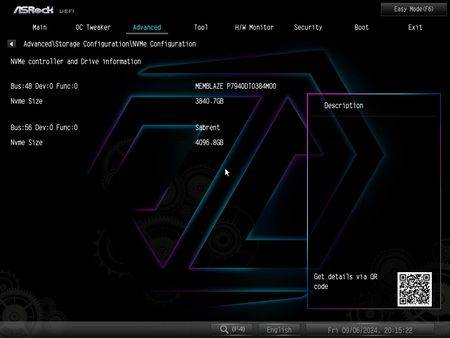
Strangely enough even though my Z790 had issues detecting the drive the X670E worked flawlessly.
TEST BED
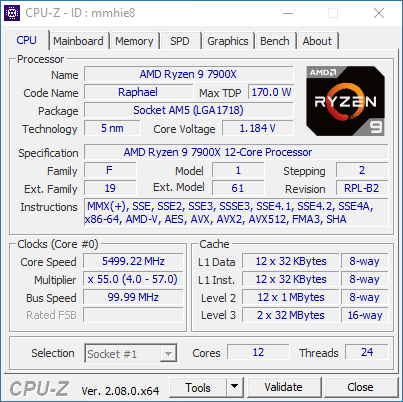

TESTING METHODOLOGY
I've been using pretty much the same testing methodology for PCIe 3.0 Gen3 and PCIe 4.0 Gen4 SSDs for far too many years now, so I decided to "tweak" it for PCIe 5.0 Gen5 models. Needless to say, Gen5 M.2 NVMe SSDs will be tested using one of my latest test rigs (AMD Ryzen 9 7900X / ASRock X670E Taichi) and unlike with both Gen3 and Gen4 SSDs I will not be using the SNIA (Storage Networking Industry Association) 12 hour IOMeter benchmark since it proved to be rather heavy for Gen5 SSDs, at least for current models (temperature issues). Instead, I decided to use the latest versions of 3D Mark, AIDA64, AS SSD, ATTO, Crystal Disk Mark, HD Tune Pro, HD Tach RW, Performance Test, IOMeter (4k Random Writes / 4k Random Reads – since September 2024 / SNIA Mixed) and Sandra Titanium for performance measuring and ForSpoken for all of you who might be wondering just how well Gen5 SSDs do in regards to Microsoft's DirectStorage API/Technology. Each test will be run a total of 5 times after which the average number will be recorded in each chart.
TEST RESULTS - AIDA64 / ATTO
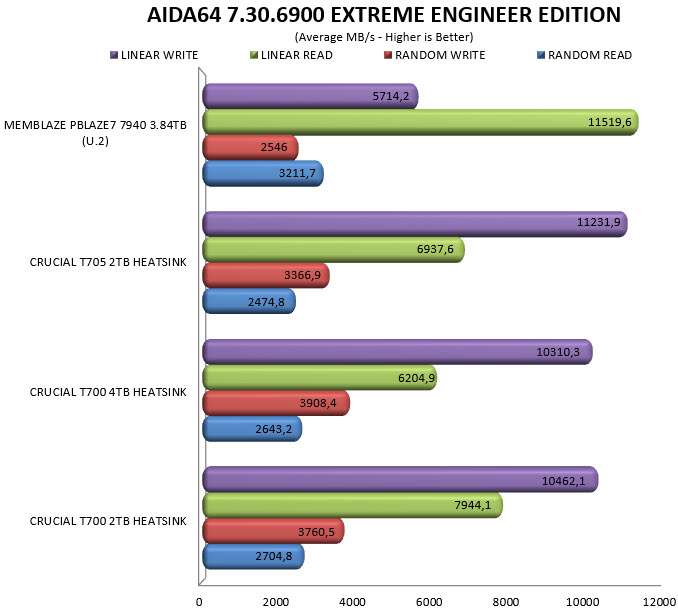
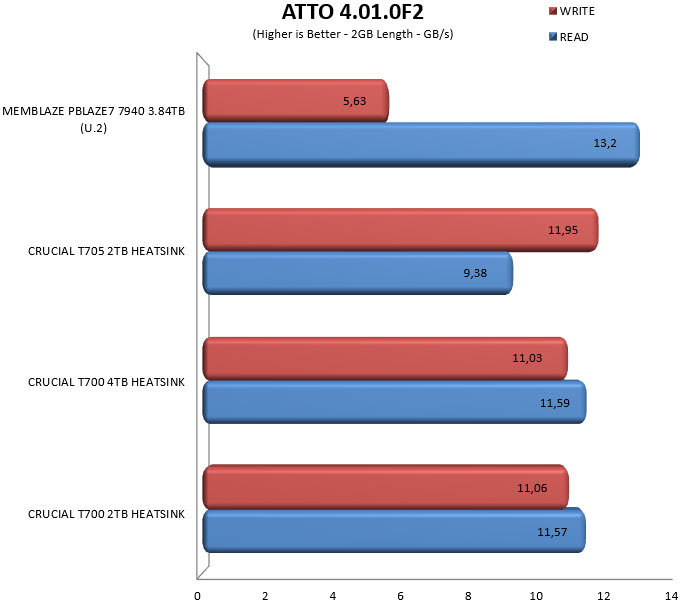
TEST RESULTS - HD TUNE PRO / HD TACH RW
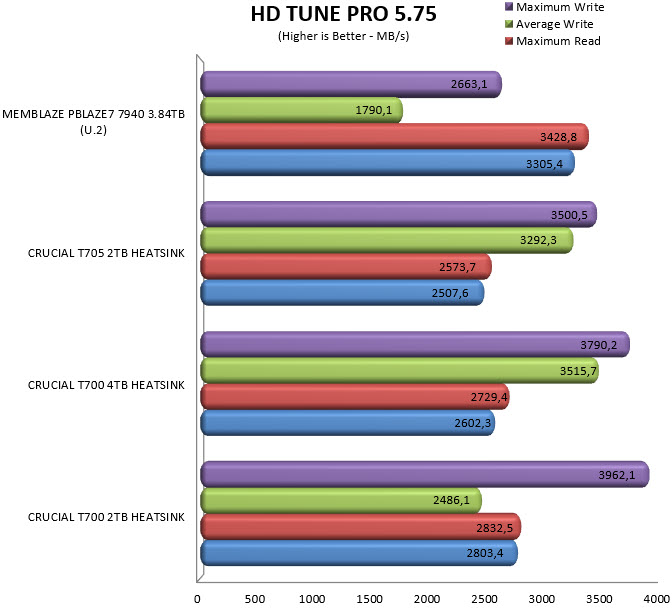

TEST RESULTS - AS SSD / CRYSTAL DISK MARK
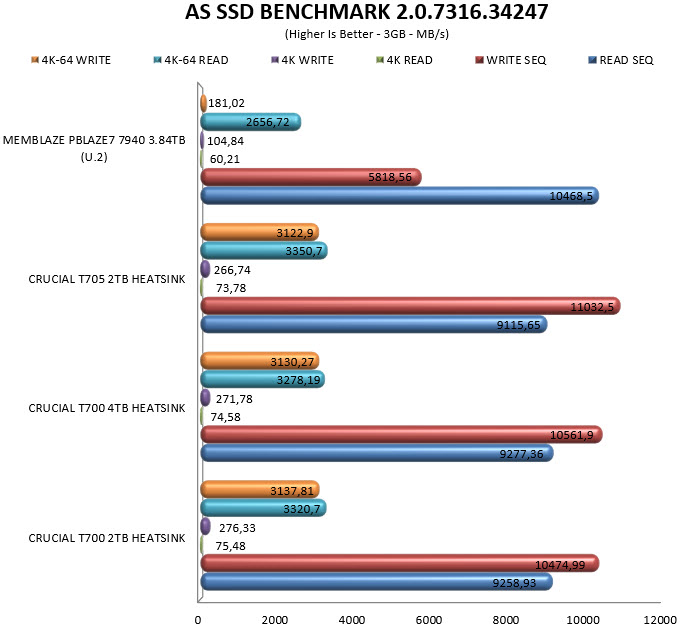

TEST RESULTS - SANDRA TITANIUM / IOMETER

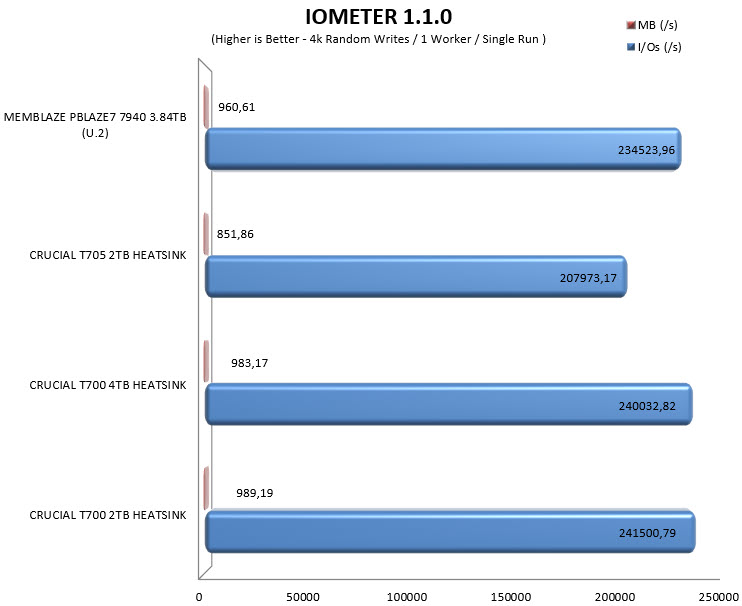
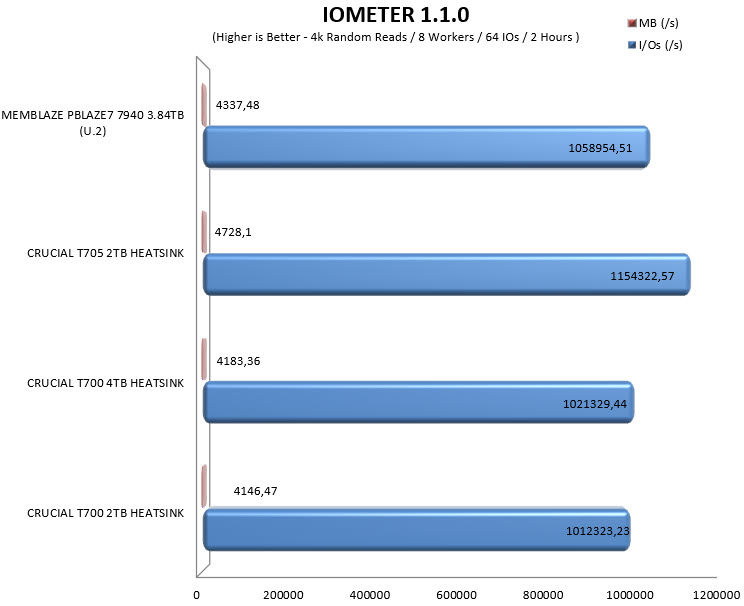
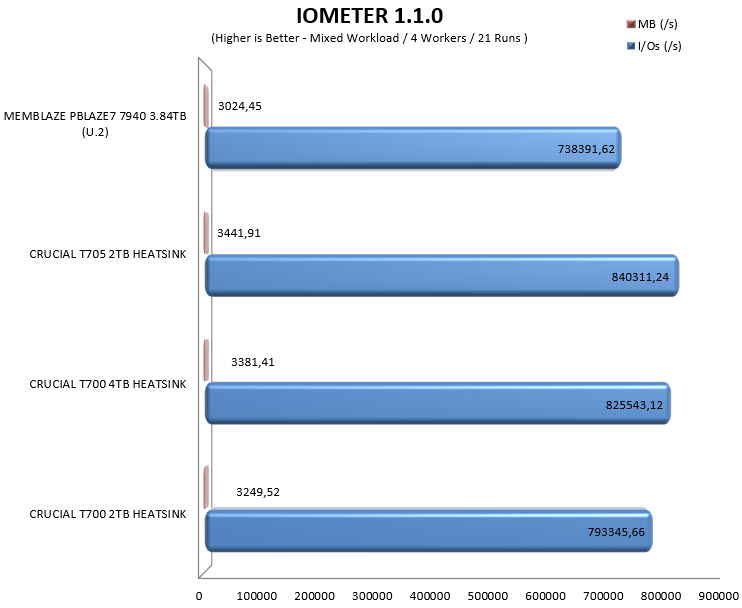
TEST RESULTS - PERFORMANCE TEST / 3D MARK / FORSPOKEN

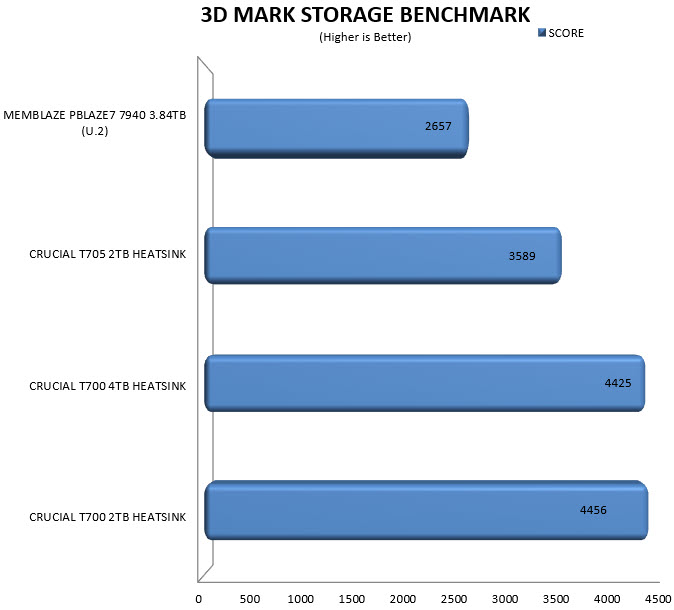
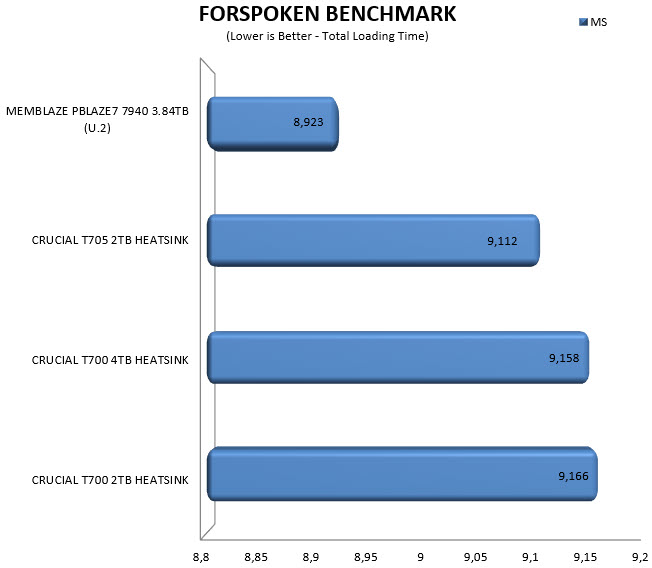
CONCLUSION

Two things I need to point out before getting into the PBlaze7 7940 U.2 drive. First that I re-introduced the Mixed SNIA test in the charts (had removed it along with the 12 hour one but since Gen5 SSDs can finish it I thought it would be nice to have) and 2nd that I introduced both 3D Mark (storage benchmark) and a 2-hour IOMeter test primarily “tailored” for data center drives (4k random reads). With that out of the way this review makes 2 things clear, 1st that the PBlaze7 7940 U.2 drive focuses mostly in reads rather than writes (very good read performance which does make sense for such a drive - do keep in mind that the PBlaze7 offered stable/steady performance as opposed to both the T700 and T705) and second that as expected from an enterprise model it’s massively more durable compared to regular consumer oriented Gen5 SSDs (roughly 1 million hours more and 5 times the total TBW compared to most consumer Gen5 models). Basically, placing the PBlaze7 in the same charts as commercial Gen5 SSDs may not be ideal but until more such drives arrive in the lab (at which point I will introduce new charts) I thought it would be better to have a comparison in place. Last but not least with a power consumption surpassing 22W while at load (25W reported by Memblaze so more or less accurate) the PBlaze7 7940 U.2 is almost twice as power hungry compared to for example the T705 4TB by Crucial (review soon – around 12W during IOMeter Mixed testing) but this is to be expected for one such drive.
At the time of this review availability for the PBlaze7 7940 3.84TB U.2 Gen5 SSD by Memblaze is far from great, at least outside Asia (where it retails for just over USD900 - far from affordable for most people, although not for large companies). Of course, such drives are bought in large quantities by enterprises and well, to date Memblaze has sold well over 150.000 of them all over the globe. At the end of the day thanks to both its performance and durability the PBlaze7 7940 3.84TB U.2 is ideal for enterprise use and yes, even very demanding professionals and consumers and that’s why it gets the Platinum Award.

PROS
- Excellent Quality
- Top Performance (Up To 14000MB/s)
- 2.5” Aluminum Enclosure (Low Temperatures)
- DirectStorage Improvements
- Available Form Factors
- Available Capacities
- Technologies / Features
- Endurance / Durability (2.5 Million Hours MTBF / 7000 TBW)
- 5 Year Limited Warranty
CONS
- Price (For Some)
- Current Availability
- Writes (For Some)

 O-Sense
O-Sense




















.png)

